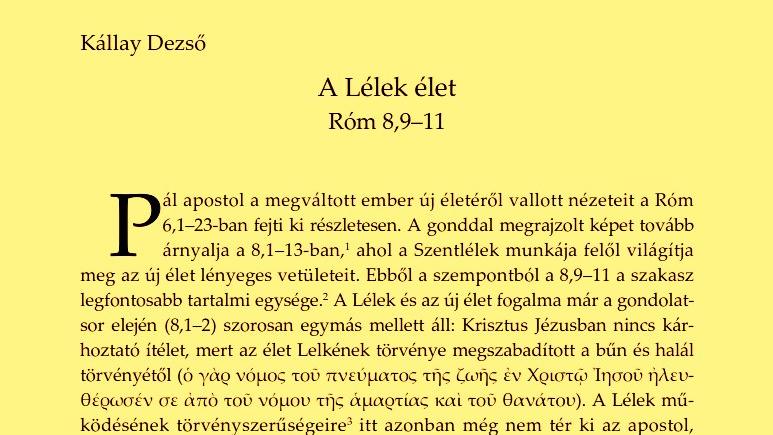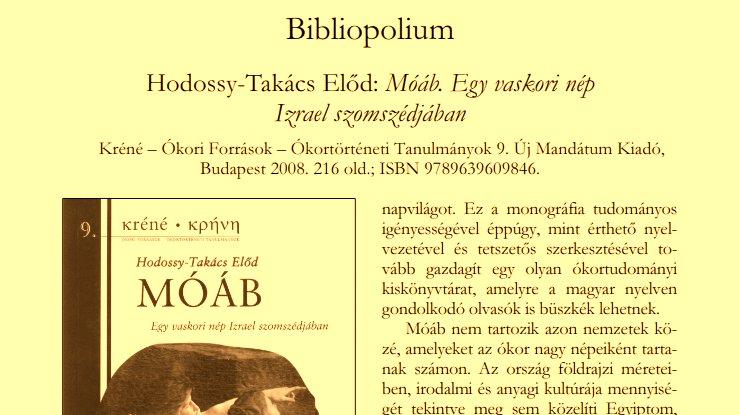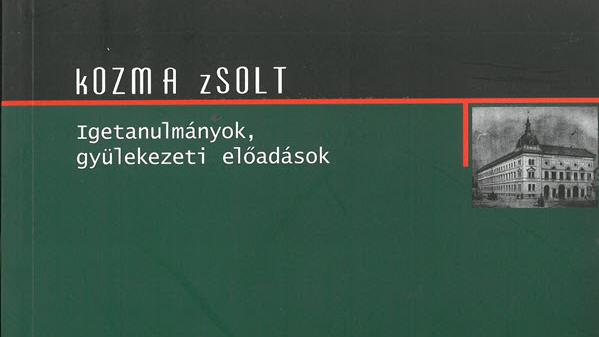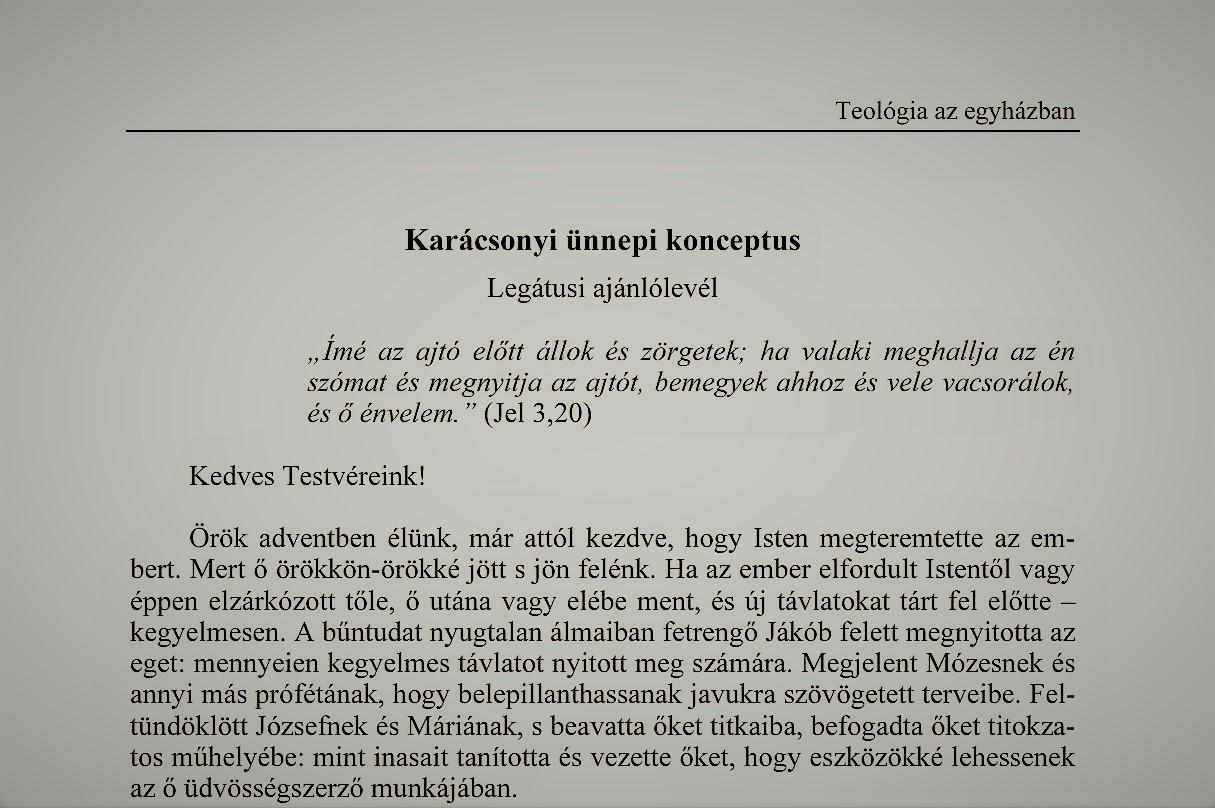Publications

Benyik György › 2021 › Pages: 104--125Jeromos – Szent Jeromos, teljes nevén latinul: Sophronius Eusebius Hieronymus (Ιερώνυμος) (347–419/20) műveltségét a család, a korabeli római társadalom, a római tanulmányok, majd a kutató-könyvkereső útjai, a szerzetesközösségek-ben szerzett tapasztalatai, valamint a barátaival és ellenségeivel folytatott levelezése és polémiái határozzák meg. Életében, érzelemvilágában a görög, latin, héber, arám, szír nyelvi kultúra, valamint a pogány és a keresztény kultúra ötvöződik, vagy éppen küzd egymással. Mivel Afrikát, Hispániát és Britanniát leszámítva csaknem az egész Római Birodalmat bejárta…
Research article › Church history › bibliaértelmezés, klasszikus műveltség, Jeromos
Benkő Timea › 2021 › Pages: 90--103Jelen tanulmányban arra a kérdésre keressük a választ, hogy mi a záróevangélium liturgiatörténeti háttere, és mi az evangélikus liturgiában betöltött szerepe és teológiai jelentése.
Research article › Practical theology, Church history › liturgia-történet, evangélikus liturgia, úrvacsora
Bekő István Márton › 2021 › Pages: 64--89A csodaelbeszélések a mindenkori gyülekezetek életében szólaltak meg, az adott kor történelmi keretei között, a teljes evangélium, kor, ha-tások és Biblia összefüggésében. A gyülekezetek megértési folyamata épített a keresztyén közösség hitfelfogására, krisztológiájára és teológiai gondolkodására, az átélt tapasztalatokra, és reménységére. Az elvégzett tárgyalás megmutatta, hogy a történeti kutatás eredményei az új hermeneutikai felismerések között és az új írásértelmezési szempontok által is hasznosíthatóak, és felhasználásuk nélkülözhetetlen a tudományos igénnyel végzett teológiai…
Research article › New Testament › exegézis (szövegértelmezés), újszövetségi exegézis, recepciókritika
Bartha Éva, Horváth Levente › 2021 › Pages: 40--63Az ember az Istennel való együtt járásában létezik („létrejön”, pontosabban identitása ebben „jön létre”), következésképpen mind a lelkigondozó, mind a gondozottja identitása is, antropológiai értelemben (mint szerény kalauz / kísérő a klienssel való együtt-haladása sajátos történetében), e dinamikus reláció kontextusában valósul meg, azaz létezik, és abszolút értelemben ezt nevezhetjük terápiának, illetve bármilyen legitim lelkigondozói intervenció sajátos útjának és a lelki „egészség” teológiailag indokolt helyreállításának (azaz Istenképűségünk eszkatológiailag anticipált…
Research article › Practical theology › lelkigondozás, közösségi lelkigondozás, trinitárius modell, antropológia, kegyesség (spiritualitás)
Balogh Csaba › 2021 › Pages: 9--39Nebukadneccar egyik terjedelmesebb felirata a brisai sziklafelirat, az észak-libánoni térségből. A tanulmány ennek a feliratnak az akkád nyelven írt verzióját és annak magyar fordítását tartalmazza, bevezetővel és mindenekelőtt az Ószövetség olvasóit szem előtt tartó jegyzetanyaggal. A brisai felirat egyrészt a babiloni fogság előtti korszak története, másrészt általában a bibliai történetírás és szellemtörténet szempontjából is fontos kordokumentum. A felirat helyenként reflektál az Újbabiloni Birodalom nyugati térséggel kapcsolatos ténykedéseire és politikájára is.
Research article › Old Testament, Varia, Antiquity › Ószövetség és ókori Közel-Kelet, Babiloni Birodalom, Nebukadneccar (Nabukodonozor), Libanon, akkád nyelvű szöveg
Balogh Csaba, Kolumbán Vilmos József › 2021 › Pages: 815Adorjáni Zoltán, a Kolozsvári Protestáns Teológiai Intézet újszövetséges professzora 2021. november 13-án töltötte a 65. életévét. A tiszteletére megjelent könyv 43 szerző tanulmányát tartalmazza. A kötet szerzői több szálon kötődnek az ünnepelthez: jelenlegi kollégák és egykori kollégák, testvérintézmények tanárai, tanítványok, barátok. Az itt megjelenített tanulmányok tartalmilag érintik a biblicum, a rendszeres teológia, a gyakorlati teológia, az egyháztörténet, a művészettörténet és művelődéstörténet területeit.
Collection of studies › Old Testament, New Testament, Systematic theology, Practical theology, Church history, Varia, Spirituality, Antiquity, Art history, Music › tanulmánykötet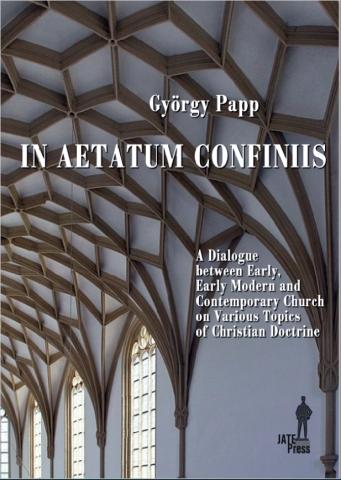
Papp György › 2021 › Pages: 175--180Bibliography › Systematic theology, Church history › bibliográfia
Papp György › 2021 › Pages: 161--173The paper presents some aspects of the theological science which I considered important for the permanent renewal of doing theology in the Hungarian Reformed Church of Transylvania. I hope I made it clear through this paper that doing theology means also the shaping of a new life (both of the one doing theology and their readers), which is conceived and developing in the safety of the living-space of the New Covenant through Jesus, i.e., the Kingdom of God, which came near us. This new life, i.e., the “Kingdom-membership” implies also new understanding: a new understanding not only of the…
Research article › Systematic theology, Varia, General theology › erdélyi magyar református teológia
Papp György › 2021 › Pages: 146--158Theis paper analyses the concept of “imago Dei” based on the 6th answer of the Heidelberg Catechism. I chose this topic as it is one of the most controversial questions of systematic theology. If one browses through the dogmatic and ethical works written from the earliest period of Christianity to the most recent times, they will find a large variety of answers. All of these attempt to explain what the writer of Genesis meant by the expression na‘aśęh ’ ādām beṣalmenu kidemutenu. The Heidelberg Catechism deals with this topic in the 6th answer where the authors attested that God did not…
Research article › Systematic theology, Church history › Heidelbergi Káté, imago Dei, istenképűség
Papp György › 2021 › Pages: 119--145This paper presents the doctrine on baptism in the Haereticarum fabularum compendium of Theodoret of Cyrus. From this presentation we learn that Theodoret presents in this work a multi-contextual image of the “all-holy” baptism. The divine origin of the sacrament determined Theodoret to offer it a special place within his theological system. This special place is expressed through the setting of the chapter concerning baptism as well: it is put between the soteriological Christology and the chapters concerning Theodoret’s eschatology, the latter being an introduction to the ethical…
Research article › Systematic theology, Church history › keresztség, tévtanítás
Papp György › 2021 › Pages: 99--118This paper is an expanded and somewhat more elaborated version of an earlier study in which I tried to give a general overview on the word-usage concerning the passion of Jesus Christ in the early Christian creeds. The purpose of this short paper is in part to give a comparative presentation of the sufferings of Lord Jesus Christ in the Western Creeds, and in part I also try to define the role of mentioning the name of Pontius Pilatus in them.
Research article › Systematic theology › Jézus Krisztus szenvedése, szenvedéstörténet, szenvedő Messiás, korai keresztyén hitvallások
Papp György › 2021 › Pages: 7--97This paper was my MA thesis, and its topic is the reception of the teaching of the Church Fathers concerning the baptism in the 1559 edition of John Calvin’s Institutes. In this thesis, I try to unfold some of the factors that determined the way Calvin used the writings of the Church Fathers in formulating his doctrine of baptism. After presenting the patristic quotations related to the ‘theoretical’ theology of baptism, I will present the quotations and references that are related rather to the practice of baptism. Here I analyse the references regarding the doctrine of baptism coming…
Research article › Systematic theology, Church history › keresztség, egyházatyák
Kovács Sándor › 2013 › Pages: 57--81Research article › Church history › Dávid Ferenc, Securitatea, erdélyi unitárius egyház
Kató Szabolcs Ferencz › 2011 › Pages: 38--53A Dávid és Góliát-elbeszélés ókori szövegtanúi között nagy eltérések vannak, ti. a Codex Vaticanus (LXXB) egy jóval rövidebb tudósítást tartalmaz Góliát legyőzéséről. A 12–31; 41; 48b; 50; 55–58 versek hiányoznak a LXXB 17. fejezetéből, melyeket csak a masszoréta szöveg (MSZ) tartalmaz: . Ezzel kapcsolatosan felmerül a kérdés: melyik a régebbi olvasat? Hogyan és miért jön létre ekkora eltérés? A tanulmány ezekre a kérdésekre keresi a választ, és közöl egy új magyarázati lehetőséget.
Research article › Old Testament › Dávid és Góliát, textual history, redaction history (composition history), irodalomkritika, Septuaginta
Balogh Csaba › 2009 › Pages: 47--52This article discusses the MT of Isa 33,12 and argues that the verse line "the nations will be burned to lime (שִׂיד)" is difficult in its context and distorts the parallelism, describing the fall of the enemy of Judah with the help of plant-imagery. Although Am 2,1 is often mentioned in connection with Isa 33,12, closer analysis shows that there are differences between the two texts. It is suggested that the LXX should be followed here, which goes back to a Hebrew text reading שָׂדַי, "field", "(agricultural) land" instead of שִׂיד, "lime". This…
Research article › Old Testament › Ézsaiás könyve, szövegkritika
Koppándi Botond Péter › 2010 › Pages: 87--91Meditation, sermon › Practical theology › igehirdetés (prédikáció)
Koppándi Botond Péter › 2003 › Pages: 83--88Meditation, sermon › Practical theology › igehirdetés (prédikáció), unitárius prédikáció
Kovács Sándor › 2017 › Pages: 359--385Research article › Church history › Confessio Fidei Exulum Christi, Déva vára, Dávid Ferenc epitáfiuma
